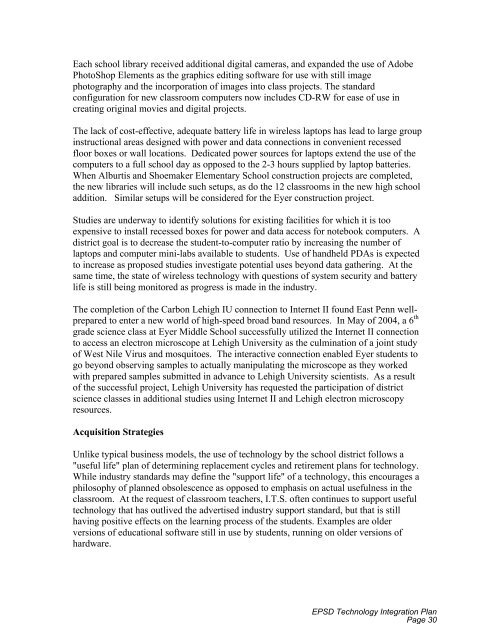EPSDtechintplan2004
EPSDtechintplan2004
EPSDtechintplan2004
Create successful ePaper yourself
Turn your PDF publications into a flip-book with our unique Google optimized e-Paper software.
Each school library received additional digital cameras, and expanded the use of Adobe<br />
PhotoShop Elements as the graphics editing software for use with still image<br />
photography and the incorporation of images into class projects. The standard<br />
configuration for new classroom computers now includes CD-RW for ease of use in<br />
creating original movies and digital projects.<br />
The lack of cost-effective, adequate battery life in wireless laptops has lead to large group<br />
instructional areas designed with power and data connections in convenient recessed<br />
floor boxes or wall locations. Dedicated power sources for laptops extend the use of the<br />
computers to a full school day as opposed to the 2-3 hours supplied by laptop batteries.<br />
When Alburtis and Shoemaker Elementary School construction projects are completed,<br />
the new libraries will include such setups, as do the 12 classrooms in the new high school<br />
addition. Similar setups will be considered for the Eyer construction project.<br />
Studies are underway to identify solutions for existing facilities for which it is too<br />
expensive to install recessed boxes for power and data access for notebook computers. A<br />
district goal is to decrease the student-to-computer ratio by increasing the number of<br />
laptops and computer mini-labs available to students. Use of handheld PDAs is expected<br />
to increase as proposed studies investigate potential uses beyond data gathering. At the<br />
same time, the state of wireless technology with questions of system security and battery<br />
life is still being monitored as progress is made in the industry.<br />
The completion of the Carbon Lehigh IU connection to Internet II found East Penn wellprepared<br />
to enter a new world of high-speed broad band resources. In May of 2004, a 6 th<br />
grade science class at Eyer Middle School successfully utilized the Internet II connection<br />
to access an electron microscope at Lehigh University as the culmination of a joint study<br />
of West Nile Virus and mosquitoes. The interactive connection enabled Eyer students to<br />
go beyond observing samples to actually manipulating the microscope as they worked<br />
with prepared samples submitted in advance to Lehigh University scientists. As a result<br />
of the successful project, Lehigh University has requested the participation of district<br />
science classes in additional studies using Internet II and Lehigh electron microscopy<br />
resources.<br />
Acquisition Strategies<br />
Unlike typical business models, the use of technology by the school district follows a<br />
"useful life" plan of determining replacement cycles and retirement plans for technology.<br />
While industry standards may define the "support life" of a technology, this encourages a<br />
philosophy of planned obsolescence as opposed to emphasis on actual usefulness in the<br />
classroom. At the request of classroom teachers, I.T.S. often continues to support useful<br />
technology that has outlived the advertised industry support standard, but that is still<br />
having positive effects on the learning process of the students. Examples are older<br />
versions of educational software still in use by students, running on older versions of<br />
hardware.<br />
EPSD Technology Integration Plan<br />
Page 30


